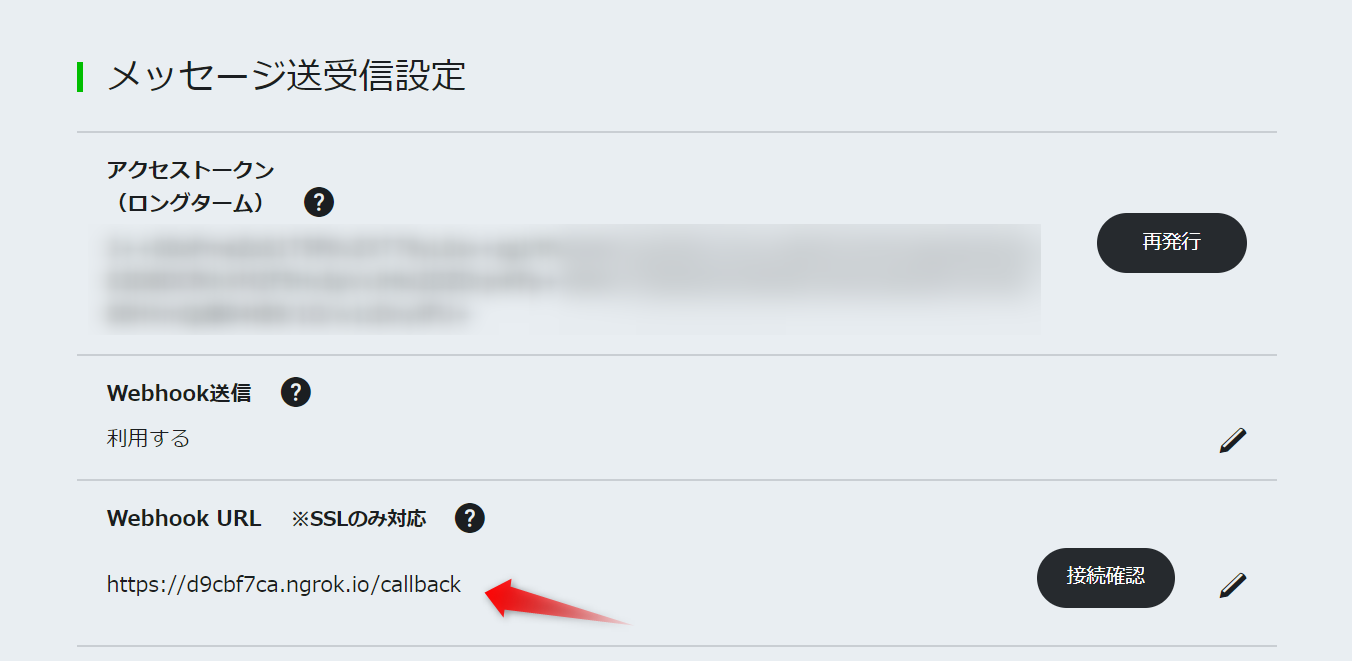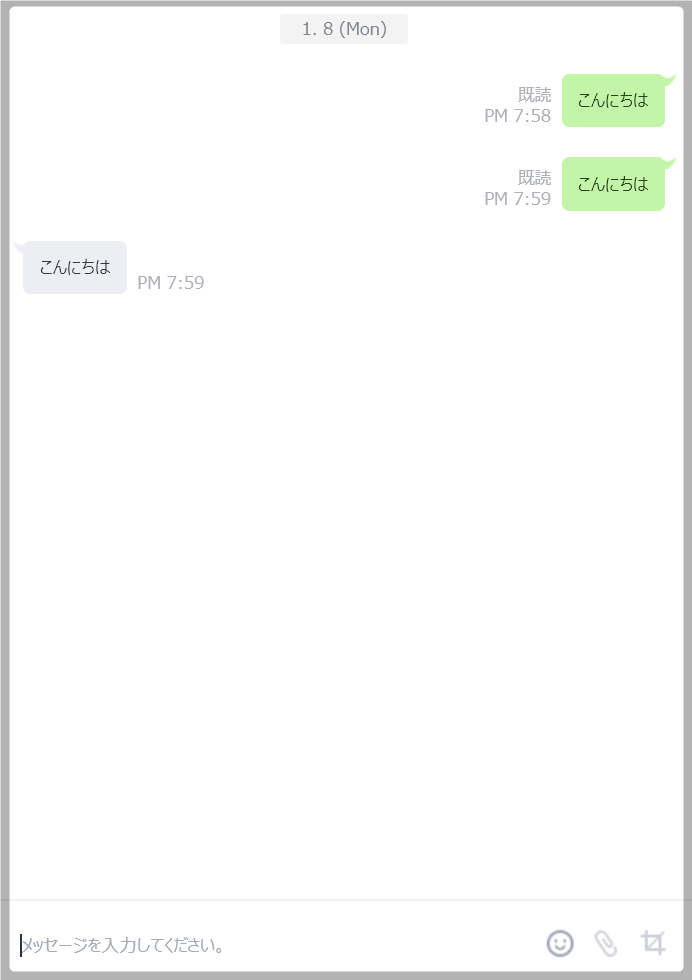はじめに
LINE Botを開発するにあたって、herokuやAWS等のPaaSやIaaSを使用している方が多いと思いますが、修正の度に毎回デプロイするのは面倒だと思います。
そこで、Ngrokをというツール使用して普通のwebアプリケーションを開発するように手軽にローカル環境でLINE Botを動かしたり、デバッグしたりする方法を紹介します。
ちなみにLINE BotはRails前提で書いています。
環境
- OS : Ubuntu 16.04.3
- Ruby : 2.4.2
- Ruby on Rails : 5.1.4
- OS : Windows 8.1
- Ngrok
※Windows上からvagrantでRails環境を動かしています
1. LINE Developersでの設定
1-1. チャネルの作成
以下の公式の手順を参考にBOT用のチャネルを作成します。
https://developers.line.me/ja/docs/messaging-api/getting-started/
1-2. コンソールでボットを設定
続いて、以下コンソールより作成したチャネルの設定を行います。
https://developers.line.me/console/
ここでは、[Webhook送信] を選択してwebhookを有効にします。
また以下のキーを控えておきます。
- Channel Secret
- アクセストークン(ロングターム)
2. Rails初期セットアップ
rails newでプロジェクト作成します。不要なものはオプションで省きます。
bundle exec rails new sample_bot --skip-turbolinks --skip-test --skip-bundle
Gemfileを修正します。
初期設定のままでも問題ないですが、gem 'line-bot-api'は追加しておきます。
source 'https://rubygems.org'
gem 'rails', '~> 5.1.4'
gem 'puma', '~> 3.7'
gem 'line-bot-api'
group :production do
gem 'pg', '0.18.4'
end
group :development, :test do
gem 'sqlite3'
gem 'byebug', platforms: [:mri, :mingw, :x64_mingw]
gem 'better_errors'
gem 'binding_of_caller'
gem 'rspec-rails'
gem 'rails-controller-testing'
end
group :development do
gem 'web-console', '>= 3.3.0'
gem 'listen', '>= 3.0.5', '< 3.2'
gem 'spring'
gem 'spring-watcher-listen', '~> 2.0.0'
end
gem 'tzinfo-data', platforms: [:mingw, :mswin, :x64_mingw, :jruby]
bundle installします。
bundle install --without production
以下でrailsが起動すれば完了です。
bundle exec rails server
2. オウム返しBOTの実装
とりあえずオウム返しするbotを実装します。以下の公式SDKのサンプルをベースに作成します。
https://github.com/line/line-bot-sdk-ruby
Rails.application.routes.draw do
post '/callback', to: 'webhook#callback'
end
require 'line/bot'
class ApplicationController < ActionController::Base
protect_from_forgery with: :null_session
before_action :validate_signature
def validate_signature
body = request.body.read
signature = request.env['HTTP_X_LINE_SIGNATURE']
unless client.validate_signature(body, signature)
error 400 do 'Bad Request' end
end
end
def client
@client ||= Line::Bot::Client.new { |config|
config.channel_secret = ENV["LINE_CHANNEL_SECRET"]
config.channel_token = ENV["LINE_CHANNEL_TOKEN"]
# ローカルで動かすだけならベタ打ちでもOK
# config.channel_secret = "your channel secret"
# config.channel_token = "your channel token"
}
end
end
class WebhookController < ApplicationController
def callback
body = request.body.read
events = client.parse_events_from(body)
events.each { |event|
case event
when Line::Bot::Event::Message
case event.type
when Line::Bot::Event::MessageType::Text
message = {
type: 'text',
text: event.message['text']
}
client.reply_message(event['replyToken'], message)
when Line::Bot::Event::MessageType::Image, Line::Bot::Event::MessageType::Video
response = client.get_message_content(event.message['id'])
tf = Tempfile.open("content")
tf.write(response.body)
end
end
}
"OK"
end
end
application_controller.rbで参照する環境変数をサーバに設定しますが、ローカルで動かすだけならベタ打ちでも問題ないでしょう。
-
ENV["LINE_CHANNEL_SECRET"]-> LINE Developersのコンソールから取得したChannel Secret を指定 -
ENV["LINE_CHANNEL_TOKEN"]-> LINE Developersのコンソールから取得したアクセストークンを指定
3. ローカルで動かす
ここからがローカルで動かすメインの手順です。以下の手順に従いローカルでLINE Botを動かす環境を整えます。
3-1. Ngrokのインストール
Ngrokを以下からダウンロードして解凍します。
https://ngrok.com/
※解凍したフォルダにpathを通しておいて下さい。
3-2. Ngrokの起動
- vagrant等を利用してゲストOSでRailsを動かしている場合
ngrok http -host-header=rewrite 192.168.33.10:3000
# ローカルからアクセスできるRailsのURL(この場合は192.168.33.10:3000)にリライトするように指定します
- ローカルでRailsを動かしている場合(
http://localhost:3000でアクセスできる場合)
ngrok http 3000
# リライト不要で ngrok http 3000でOK
↓の感じで起動するので、https://d9cbf7ca.ngrok.ioの部分をコピペします。LINEのWebhook URLはhttpsであることが必須ですが、以下の通り、httpsで起動していることがわかります。
ngrok by @inconshreveable
Session Status online
Version 2.2.8
Region United States (us)
Web Interface http://127.0.0.1:4040
Forwarding http://d9cbf7ca.ngrok.io -> 192.168.33.10:3000
Forwarding https://d9cbf7ca.ngrok.io -> 192.168.33.10:3000
Connections ttl opn rt1 rt5 p50 p90
0 0 0.00 0.00 0.00 0.00
3-3. LINE DevelopersからWebhook URLを設定
https://developers.line.me/ja/

先ほどコピペしたURL + /callback を指定します。
3-4. Railsの起動
bundle exec rails server
3-5. LINEから稼働確認
ここまででローカルから稼働確認できる環境が整いましたので、作成したBOTを友だち追加して、実際にLINEからメッセージを送ってみます。

流れ的にはこんな感じでしょうか。
LINEアプリ -> LINE Messaging API -> Ngrok -> Rails(local)
デバッグも!
byebugやbinding.pryを仕込めば普通にデバッグも可能です。
(デバッグ方法はこちら→ Ruby / Ruby on Rails デバッグ方法まとめ)
[6, 15] in /vagrant/rails_app/sample_bot/app/controllers/webhook_controller.rb
6: events = client.parse_events_from(body)
9: byebug
10:
=> 11: events.each { |event|
12: case event
13: when Line::Bot::Event::Message
14: case event.type
15: when Line::Bot::Event::MessageType::Text
(byebug)
これでLINE Bot開発が加速します。よかったね。